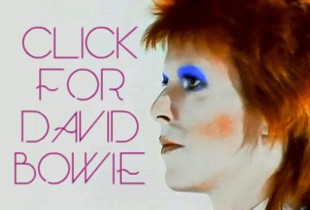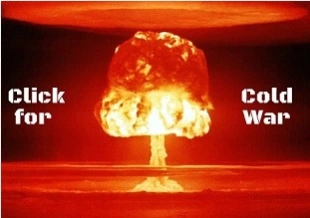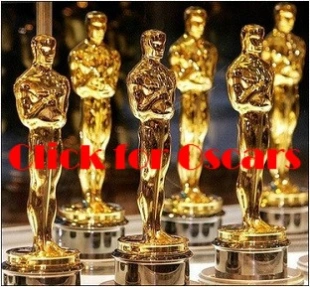40 years ago this year ~ that was when…
Us and them: prog rockers extraordinaire Pink Floyd united themselves with seemingly the entirety of the world’s record-buying public thanks to the release of their moody masterpiece – yes, the one with the above iconic light spectrum cover art – The Dark Side Of The Moon
You know, you can’t blame ’em. Peeps often look back on 1973 as one of the, well, crappier years of the Twentieth Century – constant union strikes across Britain, the Watergate scandal rocking the United States, the Arab-Israeli War igniting the Middle East and the oil crisis tipping the entire world towards recession. Yet, in spite of these unforgettable low-lights, the fourth annus of the ’70s offered significant cultural highlights too – many of which (even if we don’t remember them exactly occurring in this year) are recalled by folks with more than a smile.
So here we are then, in this, the second of George’s Journal‘s three retro ‘reviews of the year’ to conclude 2013, I give you, yes, 1973…
.
CLICK on the ‘entry titles’ for video clips
.
January 14 1973 ~ that was when…
… Elvis said aloha from Hawaii (via satellite)
Ironically for a year remembered for a depressing recession, it actually kicked-off with a sunny and breezily nostalgic, global event thanks to the campy deliciousness that was Elvis Aloha From Hawaii Via Satellite. Although actually not the first TV broadcast beamed live by the, at the time, highly space-aged seeming medium of Earth-orbiting electronic hardware (that was the one with The Beatles singing All You Need Is Love back in ’67), Elvis‘s shindig was still the first performance broadcast live via satellite by a solo performer. And, in spite of its ambitious aims (to reach 40 countries across Europe and Asia and turn around the faltering star’s fortunes) it turned out to be a roaring success. Impressively, there were no hiccups (just in case, a rehearsal had been taped two days earlier and The King had lost 25 pounds in its build-up) and the album it spawned Aloha From Hawaii: Via Satellite (1973) topped the US charts later in the year, thus giving Presley’s career the boost he and manager Colonel Parker had hoped for. Although it clearly must have achieved ginormous viewing figures, the estimation often trotted out that as many as 1 billion peeps tuned in has always been poppycock, as the combined population of the countries it was broadcast to only amounted to 1.4 billion. And surprisingly none of those was Elvis’s homeland of the US – Americans had to wait, thanks to a move to maximise viewers, until April 4, the day of the Superbowl, to catch it.
.
.
March 1 1973 ~ that was when…
… Pink Floyd took us to The Dark Side Of The Moon
Nowadays, to listen to the ultimate album for navel-gazing students from the ultimate navel-gazing rock band, it seems inevitable it became the inescapable icon we know it as. But back when it was released on this day, nobody really could have envisaged Pink Floyd’s eighth studio album Dark Side Of The Moon becoming the unstoppable runaway phenomenon that launched those nice middle-class boys from the Home Counties into the stratosphere. Don’t get me wrong, by ’73 they’d already made the heady transition from psychedelic oddity to arguable prog rock gods, but they were really on no higher a plain than the likes of Emerson, Lake and Palmer – Moon changed all that forever. The ’70s enjoyed its fair share of monster albums, all right – Carole King’s Tapestry (1971), Elton John’s Goodbye Yellow Brick Road (1973), Fleetwood Mac’s Rumors (1977) and, of course, The Bee Gee’s Saturday Night Fever (1978) among them – but none of them quite scaled the dizzy heights of the existentially angsty but utterly beautiful and brilliant Moon. Despite only topping the US charts for a solitary week, it managed to spend an incredible 741 weeks on the Billboard Hot 100 album chart between ’73 and, yes, 1988. This clearly then makes it one of the best-selling albums of all-time in the US – but it holds that distinction practically everywhere else in the world too; in the UK it’s currently the eighth biggest unit-shifter. Overall, it’s sold around 50 million copies – ironic for a record one of whose most memorable tracks (Money) sarcastically berates man’s predilection for the old green bill.
.
.
March 27 1973 ~ that was when…
… The Godfather picked up the Best Picture Oscar (but Marlon Brando rejected his)
It’s the Oscar ceremony – the 45th – that nobody has ever forgotten. Yes, the one at which a rightly rewarded Marlon Brando didn’t turn up to accept his Best Actor Oscar for playing Don Vito Corleone in The Godfather (1972), but instead sent a Native American woman Sacheen Littlefeather to read out a speech ‘on his behalf’ detailing his rejection of the gold little man. It was also the Oscar ceremony, however, at which director Francis Ford Coppola’s American mafia opus picked up a further two awards (Best Picture as mentioned and Best Adapted Screenplay), but not Best Director for Coppola himself. Somewhat oddly that went to master choreographer Bob Fosse for Nazi-themed musical Cabaret (1972) as well as a perhaps surprising seven further nods. Never mind, Franny, The Godfather Part II was just around the corner.
Read – and see – the full-story of Marlon Brando’s Oscar rejection here
.
.
May 25 1973 ~ that was when…
… Virgin Records was launched with Mike Oldfield’s Tubular Bells
For many, Tubular Bells will forever conjure up the image of Max von Sydow desperately attempting to pull Linda Blair out of her possessed state in William Friedkin’s visceral monster hit The Exorcist (1973), but maybe (in terms of its biggest legacy) it ought to conjure up the image of a rather self-satisfied smiley billionaire with a beard and a floppy mullet – namely one Richard Branson. For had he not chosen the prog rock-meets-bell-chiming opus from then utterly unknown multi-instrumentalist Mike Oldfield to open his fledgling record company, Britain’s most recognisable tycoon maybe would never have, well, become a tycoon. Having raised enough dosh from the Virgin discount record store he’d opened on London’s Oxford Street in 1971, Branson was in a position a year later to buy up an Oxfordshire pile and set it up as a recording studio, simultaneously allowing artists to record material there to be released on the Virgin record label he’d just set up. Oldfield came into contact with Branson via engineers working at the studio (known as ‘The Manor’) and Branson – liking what he heard of the work that’d be released as Tubular Bells, or maybe being slightly nuts as its commerciality had been dismissed by and all sundry already – thus picked it as Virgin Records’ very first release. The rest, of course (thanks in no small part to its opening theme being chosen by Friedkin as the theme for The Exorcist the same year giving it enormous publicity and aiding it to become the other enormously profitable music album phenomenon of ’73) is history.
.
.
June 27 1973 ~ that was when…
… Roger Moore debuted as 007 in Live And Let Die
It was the role that had doomed poor George Lazenby to a lifetime of ‘nearly man’ status (despite his effort in the now 51-year-long film series being one of the very best), thus the conventional wisdom was nobody – absolutely nobody – could follow in Sean Connery‘s tartaned footsteps. Yet, in summer ’73, one man proved that notion very wrong indeed; he was smooth, he was suave, he loved a good (or more often) bad innuendo and could raise his eyebrow faster than Connery could say Jacksh Robinshon… he was Moore, Roger Moore. And his debut effort as 007 was a stonker of a Bond film, the Blaxpoitation-tastic, speedboat chase-fuelled, voodoo-themed spectacular Live And Let Die (1973). Indeed, to this day it remains – inflation adjusted – the sixth most successful 007 blockbuster at the box-office; you’ve surely got to raise a glass to that, giant explosion behind you or not.
Read – and see – more on Roger Moore’s casting as Bond here, a review of Live And Let Die here and a celebration of the film’s 40th anniversary here
.
.
July 3 1973 ~ that was when…
… David Bowie ‘retired’ Ziggy Stardust
Ever since its launch at the Toby Jug pub in London’s Tolworth on February 10 1972, David Bowie‘s alter ego Ziggy Stardust had been an extraordinary pop culture creation – generating greater cult-like adulation from besotted teen fans than the multi-talented Bowie could have gained in his own guise perhaps, as well as serving as a shockingly red-mulletted and androgynously, outrageously attired persona into which Bowie could disappear as his fame became increasingly dizzying. Yet, following many a shocking and absurd on-stage antic (such as simulating fellatio on band member Mick Ronson’s guitar) and Bowie retreating into the character so much that he’d got into the habit of giving press conferences as him, he realised maybe for his own sanity enough was enough; it was time to ditch Ziggy. The trouble was that when he did so at a concert at The Smoke’s Hammersmith Apollo on the date above, right before fitting final tune Rock ‘n’ Roll Suicide, he did so in a manner that suggested he and his band were retiring for good rather than them just retiring the Ziggy Stardust and Spiders from Mars band (“Of all the shows on this tour, this particular show will last with us the longest because not only is it the last show of the tour, but it’s the last show we’ll ever do, thank you” – click on ‘entry title’ above). Thus, along with hundreds of fans in the venue, the music and wider press got the wrong end of the stick. In hindsight, though, it may’ve been canny on Bowie’s part, as the announcement was clearly deliberately ambiguous, ensuring it’d grant him further headlines and even greater publicity. Still, with the death of Ziggy out went too in the blink of an eye one of the most organically electric and exciting periods in rock history. Ziggy was dead and that was that.
.
.
October 17 1973 ~ that was when…
… Poland’s ‘clown’ prevented England reaching the World Cup
If the hangover the England national football team suffered at the 1970 World Cup, after the champagne supernova of winning the ’66 World Cup, wasn’t bad enough, it got a hell of a lot worse three-and-a-bit-years later. For, on this autumnal night in ’73 (seemingly reflecting the union-strike-afflicted gloom into which the nation was fast sinking), the Three Lions sank to a new – and before then utterly unthinkable – low… they conspired somehow not to beat Poland at Wembley and thus failed to reach the following year’s World Cup. It’s a well-worn tale, of course, Bobby Moore’s replacement as centre-back Norman Hunter misplaced a pass and Poland took the lead… a lead they’d hang on to until the hour-mark when England finally managed to equalise through a penalty. But a 1-1 draw wasn’t enough; despite England’s 30 shots on goal – nearly every one of them batted away by the inspired goalkeeper who became a legend that night, Jan Tomaszewski – a winning goal wouldn’t come. The repercussions were tremendous; it spelled the end for England’s World Cup-winning manager and captain, Sir Alf Ramsey and Bobby Moore respectively. And with their departure was ushered in a new era of mediocrity and disappointment, as England failed to qualify for another World Cup for eight long years. And yet, it wasn’t all bad news, for the match proved a turning point for Poland, its result ensuring they qualified for West Germany ’74 instead, where, buoyed by the enormous confidence they’d gained that night, they only went on to finish third. Brian Clough had never been more wrong – Jan Tomaszewki and this teammates turned out to be human cannonballs rather than clowns.
.
.
November 17 1973 ~ that was when…
… Richard Nixon told the world he was ‘not a crook’
Ah, Watergate… the innocuous-seeming break-in at the eponymous Washington DC hotel that, through the tireless investigative journalism of Carl Bernstein and Bob Woodward (as terrifically detailed in 1976’s All The President’s Men), grew into the near unbelievable sh*tstorm that eventually engulfed then US President Richard Milhouse Nixon’s Cabinet – and in 1974 claimed his head too. Even by the end of ’73, however, its conclusion was some time off, for it was then – the clouds darkening rather than the wagons circling – that Nixon went before the TV cameras for a Q&A and decisively declared loud and clear to the people of America and the world that he’d done no wrong. “The people”, he said, “deserve to know whether their President is a crook – well, I’m not a crook”. Fair enough, that should put a lid on it. Only it didn’t. It was a big, fat whopper. He knew only too well what those under his employ had been getting up to in trying, through illegal means, to scupper the Democrats displacing him from the White House in the previous year’s General Election, so much so he’d been trying, also through illegal means, to cover it up. In that instant, thanks to (actually fairly swift) hindsight, Nixon had sealed his fate and his reputation for the rest of his life; following this and his resignation months later to avoid impeachment, he would forever be monikered ‘Tricky Dicky’, recalled as the crooked Prez. Nowadays (more so than ever surely), Americans expect their politicians to lie, let them down and more often than not be corrupt and – excusing the controversy and unpopularity Lyndon B Johnson courted in the ’60s thanks to the disparate combo of civil rights legislation and Vietnam – much of that started here. Nixon’s claim he wasn’t ‘a crook’ is the touchstone for politicians patently telling porkies to save their skin – and getting found out.
.
And finally…
.
December 15 1973 ~ that was when…
… Britain’s Christmas went glam
By the end of ’73, held to ransom by the coal miners’ unions, the then UK Government of Ted Heath had no alternative than to introduce limits on non-essential energy use throughout the land from midnight on December 31 – yes, exactly when Big Ben would chime in 1974. A happy New Year was certainly not in prospect. Yet, as if in defiance of the candle-lit crappiness to come, Blighty seemed to prepare for the inevitable through that age-old method – it ignored it. To be exact, it indulged in a good old-fashioned Crimbo knees-up by embracing all the tinsel-tinged, bell-bottomed barmy brilliance of glam rock that dominated the music charts that December. Most memorably, of course, was the battle for the esteemed Christmas #1 between two of the last year or two’s biggest – and most colourfully, ridiculously clothed – bands, Slade and Wizzard, both hailing from the usually deeply unfashionable West Midlands. As is known by practically every bod in the country thereafter, the legendary Noddy Holder’s Slade triumphed, taking top spot with the inescapable Merry Xmas Everybody (click on ‘entry title’ above), while former The Move leader Roy Wood’s Wizzard claimed the #4 spot with the equally inescapable I Wish It Could Be Christmas Everyday. Not to be outdone, though, the (glam-related) rock star – and possibly the biggest music act in the world at the time – Elton John also released a Crimbo tune this year, yet bizarrely given it’s one of the season’s very best, Step Into Christmas managed to scale no higher than #26. Still, thanks to its glam credentials, Christmas ’73 is rightly recalled as a rather marvellous merry time, poignantly so too given the predicament the UK – and the wider world – found itself in outside its blithely innocent bubble.
.
.
US top 10 box-office
| 1. | The Sting | $156,000,000 |
| 2. | The Exorcist | $128,000,000 |
| 3. | American Graffiti | $115,000,000 |
| 4. | Papillon | $53,267,000 |
| 5. | The Way We Were | $49,919,870 |
| 6. | Magnum Force | $39,768,000 |
| 7. | Last Tango In Paris | $36,144,000 |
| 8. | Live And Let Die | $35,377,836 |
| 9. | Robin Hood | $32,056,467 |
| 10. | Paper Moon | $30,933,743 |
.
.
UK top 10 best-selling singles
| 1. | Tie A Yellow Ribbon Round The Ole Oak Tree | Dawn |
| 2. | Eye Level (Theme from Van der Valk) | The Simon Park Orchestra |
| 3. | Welcome Home | Peters And Lee |
| 4. | Block Buster! | Sweet |
| 5. | Cum On Feel The Noize | Slade |
| 6. | See My Baby Jive | Wizzard |
| 7. | I’m The Leader Of The Gang (I Am) | Gary Glitter |
| 8. | I Love You Love Me Love | Gary Glitter |
| 9. | The Twelfth Of Never | Donny Osmond |
| 10. | Spanish Eyes | Al Martino |
.
.
In memoriam…
Lyndon B Johnson (August 27 1908–January 22 1973)
Edward G Robinson (December 12 1893–January 26 1973)
Noël Coward (December 16 1899–March 26 1973)
Pablo Picasso (October 25 1881–April 8 1973)
Roger Delgado (March 1 1918–June 18 1973)
Nancy Mitford (November 28 1904–June 30 1973)
Betty Grable (December 18 1916–July 2 1973)
Veronica Lake (November 14 1922–July 7 1973)
Lon Chaney Jr. (February 10 1906–July 12 1973)
Jack Hawkins (September 14 1910–July 18 1973)
Bruce Lee (November 27 1940–July 20 1973)
John Ford (February 1 1894–August 31 1973)
JRR Tolkein (January 3 1892–September 2 1973)
Gram Parsons (November 5 1946–September 19 1973)
WH Auden (February 21 1907–September 27 1973)
Laurence Harvey (October 1 1926–November 25 1973)
David Ben-Gurion (October 16 1886–December 1 1973)
Bobby Darin (May 14 1936–December 20 1973)
.
.
.
.































Trackbacks